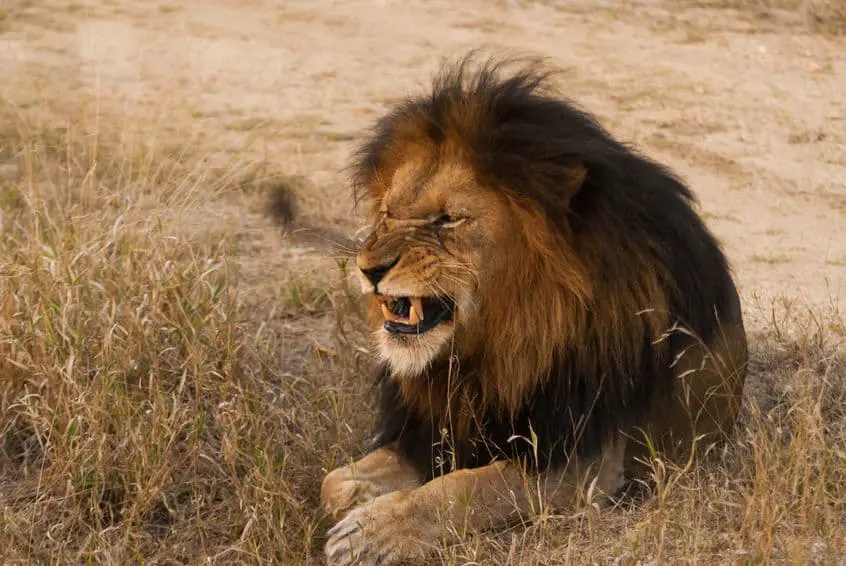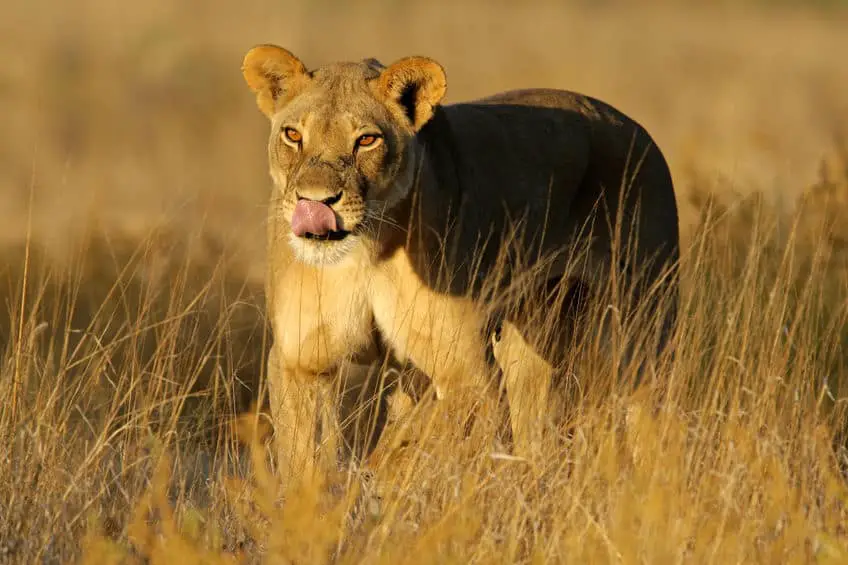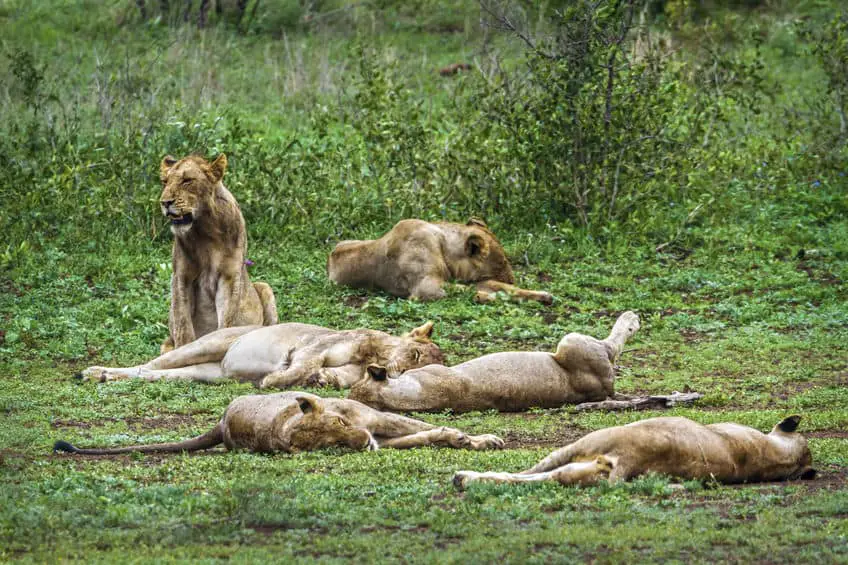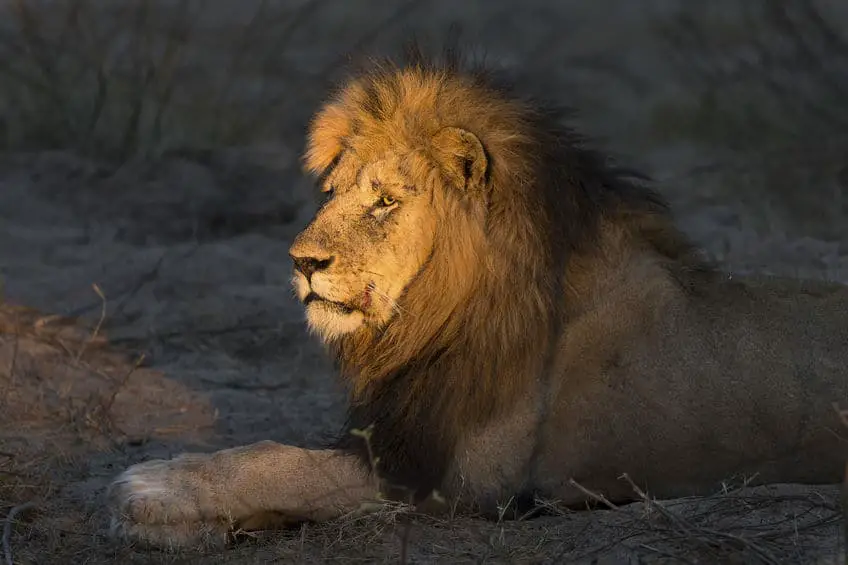
Lions are the largest of the big cats of Africa and when they hunt together, they are capable of taking down very large mammals such as Cape buffalos, hippos, rhinos, giraffes, and even young male or grown female elephants.
This post is full of interesting information and covers 20 fascinating facts about African lions but before we go into depth with each of the facts, here is a quick summary of the facts this post covers.
These are the 20 most important and fascinating facts about lions:
- Lions are the biggest cats in Africa. They can weigh up to 600 pounds (272 kg).
- Lionesses are the largest female cats in the world.
- The lifespan of lions in the wild is 16 years for males and 18 years for females.
- A group of lions is called a pride.
- Lionesses are the core of the pride.
- Lions are highly territorial animals.
- Lionesses usually have 1 to 4 cubs and raise them without the father.
- Lionesses are the primary hunters in a pride.
- In some regions, lions scavenge as much as they hunt.
- Lions can eat almost any animal they can find in their territory.
- Male lions usually get to eat first.
- Lions sleep up to 20 hours per day.
- Lions are nocturnal animals.
- The larger and darker a lions’ mane is, the stronger and more dominant the lion is.
- Lions can be seen in most of sub-Saharan Africa.
- Lions are apex predators.
- Lions do not have many natural enemies but they do have some such as Cape buffalos and elephants.
- Lions can live in many types of habitat including savanna, grassland, forest, shrubland, and deserts.
- Lions belong to the Felidae family of animals.
- The conservation status of lions is ‘Vulnerable’ and there are between 23,000 and 39,000 lions left in the wild in Africa.
Before we go into depth with each of these facts, here are some scientific facts about lions.
Scientific Facts About Lions
| Scientific name | Panthera leo |
| Family | Felidae |
| Lifespan | Male in nature: 16 years Female in nature: 18 years In captivity (male and female): 30 years |
| Solitary or social | Mostly social |
| Group name | Pride |
| Group size | 3 – 35 |
| Weight | Males: 330 – 600 lb (about 150 – 272 kg) Females 265 – 400 lb (about 120 – 180 kg) |
| Height | 3.6 – 4 ft (about 110 – 120 cm) |
| Length (head and body) | Male: 5.6 – 8.2 ft (1.7 – 2.5 m) Female: 4.6 – 5.9 ft (1.4 – 1.8 m) |
| Length (tail) | Males: 3 – 3.3 ft (90 – 100 cm) Females: 2.3 – 3.3 ft (70 – 100 cm) |
| Top speed | 50 mph (80 km/h) |
| Primary food | Zebras, wildebeests, cape buffalos, and other medium-sized or large hoofed mammals |
| Where in Africa | Sub-Saharan Africa |
| Habitat | Savanna, grassland, forest, shrubland, and desert |
| Natural enemies | Elephants, Cape buffalos, and hyenas |
| Conservation status | Vulnerable (according to IUCN) |
| Population in Africa | 23,000 – 39,000 (according to IUCN) |
| Gestation period | 3.5 – 4 months |
| Weight at birth | 2 – 4 lb (about 1 – 2 kg) |
| Height at birth | 4 – 6 in (10 – 15 cm) |
| Number of offspring | 1 – 4 |
Lion Appearance And Anatomy
Lions can be found in most sub-Saharan countries. They are the biggest African cats and one of the most sought-after animals to see on safaris.
Male lions usually weigh between 400 and 440 pounds (about 180 to 200 kg) and female lions (called lionesses) usually weigh between 290 and 310 pounds (about 130 to 140 kg).
The size of lions can vary greatly from region to region, however, and depends largely on the prey animals that they can hunt in their territories. In territories where the prey is larger, the lions will typically get larger too.
The largest male lion ever on record weighed an incredible 600 pounds (272 kg) and the largest female lion weighed 400 pounds (180 kg).
Lions are not only heavy animals but they are also physically large.
Lions measure 3.6 to 4 feet (110 to 120 cm) in height and the length of their heads and bodies measure 5.6 to 8.2 ft (1.7 to 2.5 m) for the males and 4.6 to 5.9 ft (1.4 to 1.8 m) for the females.
Their tails add an extra 2.3 to 3.3 feet (70 to 100 cm) in length for the lionesses and 3 to 3.3 feet (90 to 100 cm) for the males.
Lions have strong, dense, and bulky bodies that are packed with strength and muscle. They have large, strong legs and paws and razor-sharp teeth and claws that they use to kill and eat their prey as well as defend themselves against aggressive Cape buffalos or other large threats.
Lions have a golden or yellow-colored coat of fur all over their bodies and the males have what is perhaps the most characteristic feature of them all, the mane. The mane on male lions can vary in size and color depending on the lions’ age and health.
Despite being large, strong, and bulky animals, lions are extremely good at sneaking up on prey and a large part of their hunting success can be accredited to their ability to sneak.
Another feature in lions’ appearance that makes them unique and distinguishable from other large cats is that they have a small “bush” of hair at the end of their tail.
Lionesses Are The Largest Female Cats In The World

Lions are the largest cats in Africa by far and on a global scale, the only cat that can become larger than lions is the Siberian tiger. This only goes for the males, however, as lionesses actually can get a bit larger than female Siberian tigers.
Female lions are the largest female cats in the world. They can weigh up to 400 pounds (180 kg) which is more than female Siberian tigers who can weigh up to 375 pounds (about 170 kg).
Lion Lifespan
The lifespan of lions in the wild is 16 years for males and 18 years for females.
Due to unforeseen circumstances such as diseases, natural enemies, hunting, etc., lions only rarely live for this long and the average life expectancy is 12 years for male lions and 15 years for female lions.
If they are given good conditions and taken good care of, lions have a significantly longer lifespan in captivity than they do in the wild.
Lions in captivity have a lifespan of 30 years.
The reason why the lifespan of lions in captivity is so much longer than the lifespan of lions in the wild is that threats such as natural enemies and diseases have either been completely removed or can be taken care of.
Groups Of Lions Are Called Prides
Lions are highly social creatures who spend most of their lives in groups. These groups of lions are called prides and usually have between 10 and 20 members but sometimes up to as many as 40 lions can live in the same pride.
Prides of lions consist of a small group of males (usually 2 to 5 but it can be more in large prides), a larger group of females that are usually all related to each other, and their cubs.
The size of lion prides can vary greatly from region to region and the largest prides with upwards of 40 members are mostly found in the eastern parts of Africa and primarily in Kenya and Tanzania for instance in the Serengeti National Park or the Masai Mara National Reserve.
In the southern and western parts of Africa, lion prides are usually smaller with less than 15 members and sometimes as few as just 3 members.
There are exceptions to this, however, as you can see in this incredible footage from the Kruger National Park of South Africa, where a very large pride of lions is walking on a road right next to the car the person who is recording is in.
Lionesses Are The Core Of The Pride
One of the many very interesting things about lions is found in the structure of the pride and this is also where one of the biggest differences between male and female lions is found.
Prides of lions are made up of a small group of male lions, a larger group of female lions, and their cubs. Lion prides can vary greatly in size and have between 3 and 40 members.
Lions reach sexual maturity around the age of 2 to 4 years and at that age, the young females stay in their pride and take on a stronger role where they help raising cubs until they have a litter of their own.
When male lions reach sexual maturity, they leave their pride to go out and live solitary lives until they are large and strong enough to claim a territory and a female pride of their own.
When male lions find a pride of females, they will try to kill the cubs from the previous males as this will make the female lions ready for mating faster. That way the new male lions can produce offspring of their own faster.
Female lions are definitely the core of their pride as they will stay in the same pride for their entire lives. Male lions come and go.
Lions Are Highly Territorial Animals
As we now know, lion prides are made up of a group of female lions that are usually all related to each other, their cubs, and a smaller group of male lions that come and go every few years.
These prides of females and their cubs are extremely territorial animals that can keep the same territory for decades and across generations.
The female lions in a pride work together on protecting their territory from other female prides and from male lions that are not part of their pride but instead are out to kill their cubs.
The size of a lion pride’s territory can vary from region to region and depends on an abundance of prey for the lions to hunt and on access to water sources.
Lions And Their Offspring

Lionesses have a gestation period of 3.5 to 4 months after which they give birth to a litter of cubs.
A litter of lion cubs usually consist of 1 to 4 cubs but can sometimes have up to 6.
The newborn cubs are very small and fragile. They weigh just 2 to 4 pounds (1 to 2 kg) at birth and measure about 4 to 6 inches in height.
Just like with many other animals, especially big cats, the female lions take care of and raise the cubs without much help from the males.
When the cubs are between 2 and 4 years old, the males will leave their pride and go out and live solitary lives until they are large and strong enough to claim a territory and a female pride of their own. Female lions stay in their pride for their entire lives.
Lion Hunting Style
Lions are fierce and savage hunters that will hunt and eat almost anything.
Since lions are social creatures that mostly live in prides, they also usually hunt together. This is, however, not always the case and lions can absolutely also hunt on their own.
Lions are very large and heavy cats and when they run, they burn immense amounts of energy and much of the prey lions hunt can actually outrun lions over a longer distance. So when they hunt, lions rely heavily on stealth and the ability to sneak up on their target.
When hunting on their own, lions will sneak up on their target and get as close as possible before leaping forward for the kill. The closer a lion can get to its target prey, the shorter a potential chase will be and therefore, the higher chances the lion has of a successful hunt.
When lions hunt as a group, they will often surround their target to prevent them from escaping. The lions will sneak up close to the target and when they are close enough, they will attack from different angles.
Lion prides have also been observed utilizing a strategy where a few of the lions run ahead of the rest of the pride to force their targets to move in a certain direction where the rest of the pride is waiting for them. This strategy suggests an impressive intelligence.
Lions are nocturnal animals that are active and hunt mostly at night. One of the primary advantages lions gain from hunting at night is that most of their usual prey are diurnal animals, meaning they are active during the day and sleep or rest at night. So by hunting at night, lions can preserve much more energy than they can if they hunt during the day.
When hunting alone, lions will usually hunt zebras, wildebeests, and similarly sized hoofed animals.
When hunting in groups, zebras, wildebeests, and similarly sized animals are still among the primary prey but by utilizing the power and strength gained from being a group, prides of lions can actually hunt and kill animals that are upwards of 10 times larger than themselves including young elephants, hippos, rhinos, and fully grown giraffes.
Especially Cape buffalos are among the preferred prey animals for lions and in some regions of Africa, Cape buffalos make up the majority of lions’ food.
Even though a pride of lions can hunt these very large mammals, they will usually not go after elephants, hippos, and rhinos since they are significantly harder to take down than smaller animals, not only because of their massive size and strength which makes them dangerous but also because they have very thick skin which is difficult to penetrate even with the razor-sharp teeth and claws lions have.
You may have gotten the impression that female lions do most of the work in a pride such as raising the cubs and defending their territory but that is not all. Lionesses are also the primary hunters in their prides and the male lions will mostly just wait for the females to make a kill.
Sometimes, for instance, when hunting large prey, the male lions in a pride can, however, help the lionesses with the hunting.
When hunting animals that stay in large groups such as Cape buffalos, it is much too dangerous for lions to just attack the group so to reduce the risk, the lions will try to separate one of the animals before they attack it. They will usually go for young, old, or otherwise weak animals as these are easier to separate from their groups and also easier to kill as they can’t defend themselves as much as the stronger animals can.
This strategy where a group of lions tries to separate an animal from its group can be seen in this amazing footage below. In this case, a Cape buffalo mother and its calf are isolated from the rest of their herd. This footage can be a bit graphic.
If you are interested in learning much more about how lions hunt, take a look at this post.
Lions Scavenge A Large Part Of Their Food
Lions may be fierce hunters but they can actually also obtain a rather large amount of their food by scavenging it.
How much of their food lions scavenge varies greatly from region to region and in some regions of Africa, they can scavenge upwards of 50% of all their food. In other regions of Africa, lions only scavenge around 5 or 10% of their food.
The reason why lions scavenge so much of their food, especially in some regions of Africa is that it is simply easier than hunting.
All lions scavenge but especially the males seem to prefer having others do the work for them (as we also learned about their hunting style).
Lions can use several strategies when it comes to finding food to scavenge.
Sometimes lions will look for vultures high up in the air. Vultures are experts at spotting dead animals and when they strike down, it usually means that they have found one. Since lions are so large and strong, even a large group of vultures is no match for a lion and especially not a group of lions so when they find a group of vultures eating an animal, they know they have found an easy meal.
Another strategy lions sometimes use to find dead animals to scavenge is to listen for a group of hyenas that are fighting over carrion. This can often get very loud and is therefore somewhat easy for a group of lions to find.
When scavenging, lions generally meet less competition from other predators than they do when hunting but even when scavenging, lions can meet competition, especially from hyenas and African wild dogs.
If you find this interesting and you are curious about learning more about how, why, and what lions scavenge, I highly recommend taking a look at this post.
Lions Can Eat A Huge Variety Of Animals
Lions are not at all picky when it comes to hunting and eating and they can eat almost any animal they can hunt in their territory.
Like most other species of animals, including humans, lions have their favorite food and each lion’s diet will usually consist of just a handful of different animals. What those animals are, however, depends largely on what animals are found in their territory as some animals are much more common in some areas than others.
Lions seem to prefer medium-sized or large mammals and a lion’s diet usually consists of some of the following animals.
- Zebra
- Wildebeest
- Cape buffalo
- Oryx
- Kudu
- Impala
- Springbok
- Giraffe
- Warthog
- Waterbuck
- Sable antelope
- Other medium-sized or large antelopes and other hoofed mammals.
In areas where antelopes and other medium-sized or large hoofed animals are not found in bountiful numbers, lions will hunt and eat these:
- Mice
- Lizards
- Birds
- Tortoises
- Small critters
- Crested porcupines
- Beetles
- Termites
- Snakes
- Crocodiles
- …and others
Lion Eating Behavior
When a pride of lions have succesfully killed a prey animal, it is time for a feast.
Despite being the primary hunters and most often also the ones who bring home a meal, the lionesses in a pride actually do not have priority when it comes to eating.
Male lions will make sure to eat first and will usually not allow anybody else near the food before they are full.
If a lion pride has killed a very large mammal and there is plenty of food for everybody, the males will sometimes let the lionesses and the cubs eat right away.
Female lions are quite the opposite of males when it comes to their eating behavior. They will almost always let the cubs eat first.
Sometimes, lions can go for up to 4 or 5 days without eating so when they get to eat, they will make sure to eat a lot. Lions can consume an amount of food equal to upwards of 20% of their own body weight. For the largest male lions, that means 110 pounds (50 kg) of meat.
If you are curious about lions’ eating behavior, I recommend reading this post.
Lions Sleep Up To 20 Hours Per Day

Lions are among the best sleepers, not only in Africa but in the entire world. They spend the vast majority of their time sleeping or resting.
How much do lions sleep? African male lions sleep around 18-20 hours per day on average. Female lions sleep around 15-18 hours per day. The reason why female lions sleep less than male lions is that they usually spend more time hunting or taking care of cubs.
Sleeping and resting so much are highly necessary for lions as it allows them to preserve the energy that is needed for hunting.
I recommend taking a look at this post about lions and their sleeping behavior. It is actually extremely interesting and I learned a lot when researching for that post.
Lions Are Nocturnal Animals
Lions are considered to be nocturnal but many sources also categorize them as crepuscular. This means that the lion is active primarily in the twilight period which is the time period between dawn and sunrise or between sunset and dusk.
Being active when it is dark gives lions a number of advantages.
Hunting at night allows lions to spend much less energy since most of their prey is diurnal and is usually asleep or resting at night.
Lions also have incredible night vision which makes it easier for them to sneak up on unsuspecting prey and go completely unnoticed until they are close enough to their target to strike.
Take a look at this post if you are curious about why lions are nocturnal. It goes into great detail about the advantages lions gain from being nocturnal.
The Mane Expresses Power
One of the most characteristic and well-known features male lions have is the mane. The mane is also one of the most important features for male lions as a large and dark mane expresses dominance.
The size and color of male lions’ manes vary greatly and change throughout the lions’ lives. The color of the mane can vary from very light orange to almost black.
The color and size of the mane are determined by the production of testosterone so the larger and darker the mane is, the more dominant the lion is and a lion with a large, dark mane is typically a male in the prime of its life.
Male lions with large and dark manes will often be able to intimidate other male lions and they will usually also attract more females.
When male lions become old or sick, their mane will begin to shrink in size and the color will begin to fade and become more light.
Lions Can Be Seen In Most Of Sub-Saharan Africa
Lions used to be widely distributed and found in bountiful numbers all over Africa.
Today, lions are far less common than they used to be but they can still be seen in most of sub-Saharan Africa.
The largest populations of lions are in South Africa, Botswana, Kenya, Tanzania, Zambia, and Zimbabwe.
Lions Thrive In Many Types Of Habitat
Lions thrive in habitats such as savanna, grassland, forest, and shrubland, as these usually have large populations of prey animals for the lions to hunt.
Lions can also be seen in deserts where they will hunt small critters, lizards, birds, and similar.
Lions Are Apex Predators

Lions are apex predators which means that they are at the absolute top of the food chain. No other animal hunts lions and nobody kills them to eat them.
Despite being at the top of the food chain, lions do, however, have some natural enemies that can kill them for other reasons than eating them.
Lions Have Several Natural Enemies
Many sources, especially online, claim that lions have no natural enemies since they are apex predators but that is not true. In fact, lions have several natural enemies.
Being an apex predator means that no other animal preys on you and that is absolutely true for lions but some animals can and will still kill lions either as a means of self-defense or to reduce or prevent future threats.
Lions’ primary natural enemies are very large and strong mammals such as elephants and Cape buffalos.
Especially Cape buffalos can pose a threat to lions as they are not only large but also extremely aggressive animals that will try to kill any animal that comes too close and poses a threat towards them.
Due to their massive size and strength, a Cape Buffalo would take out a lion almost every single time in a one-on-one fight. A pride of lions can, however, overpower a single Cape buffalo by utilizing the strength of the group. A single lion can sometimes take out a calf or a wounded buffalo on its own.
When lions and Cape buffalos meet, things can get violent very quickly. I have written a post that goes much more in-depth with the eternal rivalry between lions and Cape buffalos. You can find that post on this link.
Hyenas, crocodiles, leopards, African wild dogs, and jackals can also kill lion cubs if they get the opportunity. They will mostly do so to eliminate future threats or competition.
Lions Belong To The Felidae Family
Lions belong to the Felidae family of animals which is a well-known family of mammals, most commonly referred to as cats.
Other members of the Felidae family are tigers, jaguars, pumas, lynxes, and domestic cats.
In Africa, some of the most well-known Felidae family members are lions, leopards, cheetahs, servals, and caracals.
Population And Conservation Status
Lions used to be widely distributed all over Africa but are no longer found in nearly as bountiful numbers as they used to be.
Lions can still be seen in most of sub-Saharan Africa and the largest populations of lions are in South Africa, Botswana, Kenya, Tanzania, Zambia, and Zimbabwe.
According to IUCN, the global population of lions is decreasing and the conservation status of the big cat is vulnerable. There are currently estimated to be between 23,000 and 39,000 lions left in the wild in Africa.
